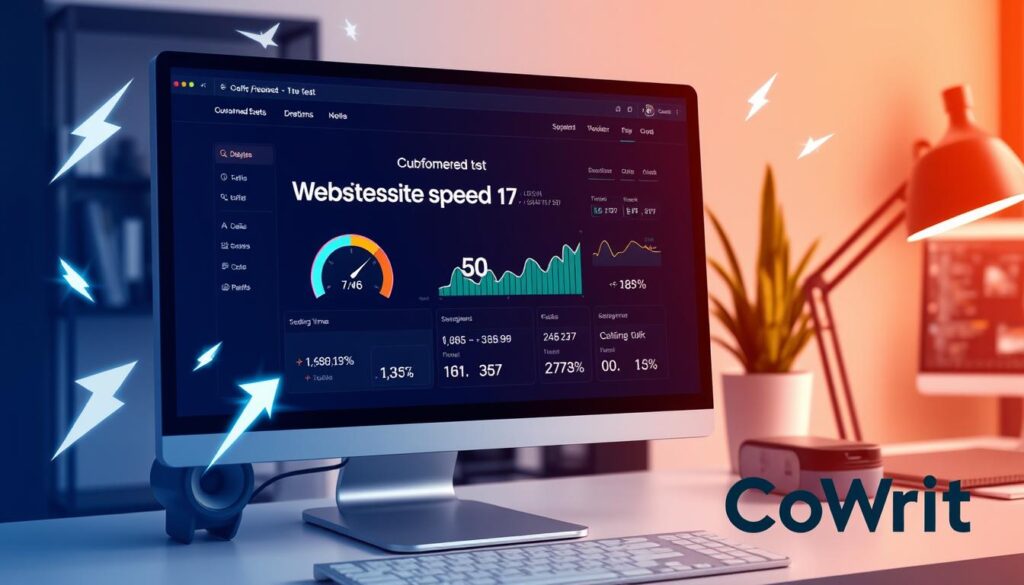In today’s fast world, making your website load quickly is key. It improves user experience and helps your business grow. Fast websites keep users happy and engaged with your brand.
Slow websites can hurt your business. A 1-second delay can drop conversions by 7%. Amazon saw a 1% revenue boost with a 100ms speed gain. Fast websites are seen as better, leading to more customer satisfaction.
Fast websites are not just good for users; they’re also good for SEO. Since 2017, Google has favored websites that load quickly and work well on mobile. Making your site load faster can boost your search rankings and traffic.
Key Takeaways
- Website speed optimization is crucial for enhancing user experience and improving conversion rates.
- A 1-second delay in page load time can result in a 7% reduction in conversions.
- Optimal load time is under 2 seconds, with 40% of users leaving a site after 3 seconds.
- Fast-loading websites are perceived as more responsive and user-friendly, leading to increased engagement and satisfaction.
- Optimizing website speed can also provide significant SEO benefits, as Google prioritizes mobile-friendly, fast-loading sites.
Understanding the Importance of Website Speed
In today’s fast world, website performance is key for user engagement and sales. A quick website keeps users happy and interested.
The Impact of Loading Times on User Experience
Even a small delay in loading can affect users. For example, Amazon lost $141 billion in sales for every 100ms delay. The BBC saw a 10% drop in visitors for each extra second.
Google also notes a 20% traffic drop for every 0.5-second delay. This shows how fast websites are important.
SEO Benefits of Faster Websites
Faster websites are not just better for users. Google also favors them in search results. Since 2017, Google has ranked mobile versions first, even for desktop searches.
Yahoo saw a 9% traffic increase for every 400ms speed improvement. Faster websites lead to better user experience and loyalty, boosting business success.
“Slow-loading websites collectively incur approximately $2.6 billion in annual losses.”
Website speed is crucial. Optimizing your site improves user experience, search rankings, and drives more traffic and sales.

Key Factors Affecting Website Speed
Having a fast-loading website is key for a good user experience and strong SEO. Several factors can greatly affect your website’s speed. These include hosting quality, server performance, website design, and file sizes.
Hosting and Server Performance
The quality of your web hosting and server can really impact your website’s speed. Shared hosting, which is common and affordable, can be slow because of shared resources. Moving to a VPS or dedicated hosting can help high-traffic sites load faster.
Website Design and Complexity
The design of your website, including elements, scripts, and integrations, can slow it down. Reducing HTTP requests by fewer elements on a page can speed things up. Also, optimizing code by minifying CSS, JavaScript, and HTML can make files smaller and load faster.
File Sizes and Types
The size and format of your website’s files, especially images, can slow it down. Using WebP instead of JPEG for images can make them smaller and load faster. Lazy loading images only when needed can also improve speed.
By focusing on these areas, you can make your website load faster. This will give users a better experience and help your SEO.

Tools for Measuring Website Speed
Checking your website’s speed is key for better user experience and SEO. Luckily, many tools can help measure and boost your site’s speed. Here are some top picks:
Google PageSpeed Insights
Google’s PageSpeed Insights is a free tool for checking your site’s speed on desktop and mobile. It gives a score and focuses on Core Web Vitals like Largest Contentful Paint and Cumulative Layout Shift. It also offers tips to make your site faster.
GTmetrix
GTmetrix is a detailed tool for website speed tests. It looks at load time, Time to First Byte, and Speed Index. It also gives advice on how to speed up your site.
Pingdom Speed Test
Pingdom’s Speed Test is easy to use and checks your site’s performance. It looks at load time, page size, and requests. It helps you find and fix speed problems.
These tools are great for improving your website’s speed. This makes your site better for users and helps your SEO.

“Improving your website’s speed can lead to a significant increase in conversion rates. Studies show that a 1-second delay in page load time can result in a nearly 40% drop in conversion rate.”
Best Practices for Website Speed Optimization
Improving your website’s speed is key for a great user experience. Focus on image compression, reducing HTTP requests, and browser caching. These steps can make your site load faster and perform better.
Optimize Images for Faster Loading
Compressing images is a top way to speed up your site. Use tools like ImageOptim, JPEGmini, or Kraken to shrink image sizes without losing quality. Also, use responsive images with <srcset> and <sizes> to fit different devices, speeding up loading times.
Minimize HTTP Requests
Lowering HTTP requests can make your site faster. Merge JavaScript and CSS files to cut down on server requests. Lazy loading images and content below the fold also helps speed up initial loads, making for a smoother experience.
Leverage Browser Caching
Browser caching stores your site’s elements locally, cutting down on repeat downloads for returning visitors. This boosts loading times, especially for frequent visitors. Set up your server’s cache headers and caching policies to make the most of this technique for performance optimization.
By following these best practices, you can make your website faster and more user-friendly. Focus on image compression, reduce HTTP requests, and use browser caching. These steps are essential for website speed optimization and keeping users happy.

Implementing Content Delivery Networks (CDNs)
In today’s fast world, making websites load quickly is key. Content delivery networks (CDNs) are a big help. They use servers all over to get content to users fast, making websites load quicker.
What is a CDN?
A CDN is a network of servers all over the world. They work together to make sure websites load fast and reliably. They store website files like images and videos on many servers. This way, when you visit a site, it loads from the closest server, making it faster.
Benefits of Using a CDN
- CDNs make websites load faster by bringing content closer to users.
- They help servers by taking off the load of delivering static content.
- CDNs make websites available more often because they have many servers.
- Global content distribution: CDNs with many servers worldwide deliver content fast, no matter where you are.
Choosing the Right CDN for Your Website
When picking a CDN, think about how many servers they have and where they are. Also, consider how easy it is to set up and how much it costs. Look for CDNs with advanced features like caching and load balancing to make your site even faster.
Using a content delivery network can make your website load faster and reduce server work. It also helps with global content delivery. This can make your website better for users and help it rank higher in search engines.
Reducing Server Response Times
Server response time is key for website speed. It’s measured by Time to First Byte (TTFB). This shows how fast a user gets the first data from the server. Making this time shorter improves user experience and SEO.
Understanding Server Response Time
Several things affect server response time. These include web hosting quality, website complexity, and database query efficiency. Research shows that fast server times, under 200 milliseconds, lead to better user engagement and SEO.
Tips for Lowering Server Response Time
To make your server faster, try these tips:
- Optimize your web hosting solution: Pick a top-notch web host or upgrade your plan. This ensures your server has the right resources for fast performance.
- Implement server-side caching: A caching system stores data for quick access. This cuts down on database queries and boosts web hosting performance.
- Optimize database performance: Make your database tables efficient. Streamline your queries for faster data retrieval.
- Use a robust content management system (CMS): Keep your CMS up-to-date and optimized. Outdated systems slow down your site.
- Consider a reverse proxy server: Use Varnish or similar to cache content. This reduces your main server’s load.
- Monitor and address server performance issues: Check your server regularly. Fix any problems to keep response times optimal.
By using these methods, you can cut your server response time. This will make your site faster, better for users, and improve SEO.
“Improving website load time by 0.1 second increases page views by 7-8% and boosts ecommerce spend by 10%.”
| Metric | Ideal Target | Great Performance | Acceptable |
|---|---|---|---|
| Server Response Time (TTFB) | 100ms or lower | 200ms or lower | 500ms or lower |
Optimizing Your Website’s Code
Making your website’s code efficient is key for faster loading and better user experience. Focus on code optimization, minification, script optimization, and clean coding. These practices can greatly improve your site’s speed and how it responds.
Minifying CSS, JavaScript, and HTML
Minifying your CSS, JavaScript, and HTML files is a great way to optimize your website. Minification removes extra whitespace, comments, and other non-essential parts without changing how your code works. Tools like WillPeavy, Script Minifier, or Grunt can help you do this, making your files smaller and faster to load.
Removing Unused Code
Getting rid of unused code is also crucial. This includes old plugins or libraries. By checking your code regularly and removing what’s not needed, you make your website faster and more efficient. This method, called clean coding, keeps your site running smoothly.
To improve JavaScript, delay non-essential scripts and use asynchronous loading. This helps your content load faster. Also, make your CSS structure simple and avoid unnecessary rules to keep file sizes down.
Optimizing your website’s code is an ongoing task. Keep checking and improving your code to make sure your site is fast and easy to use. This will help keep users happy and improve your site’s ranking on search engines.
Mobile Website Speed Optimization
In today’s world, making your website fast for mobile users is key. Google now focuses more on mobile sites when ranking them. This means your site needs to work well on all devices for better SEO.
Importance of Mobile Optimization
More than half of all internet use happens on mobile devices. A quick-loading mobile site can really help your business. Research shows a tiny speed boost can improve how people shop online.
Pages that load fast get ranked higher by Google. On the other hand, slow sites get ranked lower. This shows how crucial it is to make your site mobile-friendly.
Accelerated Mobile Pages (AMP)
Using Accelerated Mobile Pages (AMP) is a smart way to speed up your mobile site. AMP makes web pages simple and fast for mobile users. This means your site loads quicker, giving users a better experience.
To make your mobile site even faster, try these tips:
- Make images and media smaller and more mobile-friendly.
- Use fewer big, complex things that slow down your site.
- Try lazy loading to make your site load faster and use less data.
- Use tools like GTmetrix and Google Analytics to check how fast your site is and find ways to get even faster.
By focusing on mobile-first indexing and making your site fast and easy to use, you’ll attract more visitors. This can lead to more sales and better rankings in search engines.
Monitoring and Maintaining Website Speed
Keeping your website’s speed up is key for long-term success. Use tools like Google PageSpeed Insights, GTmetrix, and Pingdom for speed tests. This helps find new ways to make your site faster. Also, set up alerts for any speed problems that pop up.
Regular Speed Testing
It’s important to keep an eye on your website’s speed all the time. Use top tools like Google PageSpeed Insights, GTmetrix, and Pingdom. They check your site’s speed, find slow spots, and show how you’re doing over time.
Updating and Optimizing Content Regularly
Keeping your website fast means always working on making it better. Update your site’s content often, like compressing images and removing old stuff. Also, make sure your CMS, plugins, and themes are current for better performance.
Plan a content audit to keep all pages fast. Use real-user monitoring (RUM) tools to see how users really experience your site. This helps find and fix problems based on real user data.



